Completing a Data Entry Form
- Click a Data Entry Form template on the Templates tab.

Entering Data
- Enter alphanumeric values in the text fields.
- Enter numeric values in numeric fields.
 |
Use decimal (not comma) separators when entering data into number fields.
|
- Click
 to select a calendar date.
to select a calendar date.
- The selected day, month, and year display on the Data Entry Form.
Entering Auxiliary Data
Examples include:
- Click
 to select a Country Structure node.
to select a Country Structure node.
- The selected Country Structure name displays on the Data Entry Form
- Click
 to select an organisation.
to select an organisation.
- The selected organisation displays on the Data Entry Form.
- Click
 to select a place.
to select a place.
- Click
 to select an ordnance.
to select an ordnance.
- The selected ordnances display on the Data Entry Form.
- Enter a number in the Quantity column.
- Enter data in the other columns as necessary.
Entering Geospatial Data
 |
Enter only coordinates for absolute points.
|
- Click
 above the Points table to open the Point dialog box.
above the Points table to open the Point dialog box.
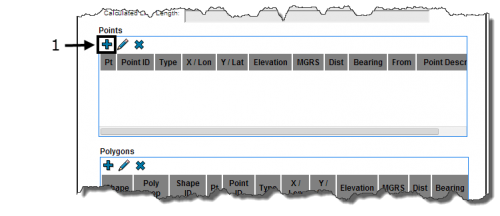
- Enter a unique numeric point number in the Point No field.
- Enter a unique alphanumeric local identifier in the Point ID field.
- Enter coordinates according to the default coordinate system and format.
- Click OK.
- The point displays in the Points table.
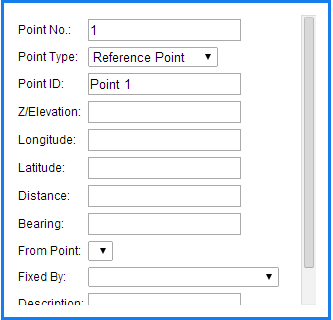
Entering a Relative Geospatial Point
- Click
 above the Points table to open the Point dialog box.
above the Points table to open the Point dialog box.
- Enter a unique numeric point number in the Point No field.
- Enter a unique alphanumeric local identifier in the Point ID field.
- Enter the distance from another point in the Distance field.
- Enter the bearing in degrees (0 to 360) from another point in the Bearing field.
- Select the Point ID of a referenced point from the From Point list.
- Click OK.
- The entered point displays in the Points table.
Adding a Polygon or Polyline
- Click
 above the Polygons table to open the Polygon/Polyline Editor dialog box.
above the Polygons table to open the Polygon/Polyline Editor dialog box.

- Enter a unique alphanumeric local identifier in the Polygon/Polyline Shape ID field.
- Select either the Polygon or Polyline option.
 |
Selecting the wrong option (such as selecting Polygon and drawing a polyline) can cause mapping errors when a Data Entry Form is imported into IMSMANG.
|
- Select an option from the Polygon Property list if required.
- Click
 above the Polygon and Polyline Points table.
above the Polygon and Polyline Points table.
- Enter polygon/polyline points into the Point dialog box the same way as when adding an absolute geospatial point or a relative point.
 |
You can use an existing point from either the Points or Polygons table to create a relative polygon/polyline point.
|
- Click OK in the Point dialog box.
- The point displays in the Polygon and Polyline Points table.
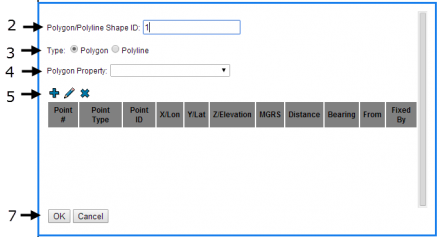
- When each of the points has been added, click OK in the Polygon/Polyline Editor dialog box.
- The points display in the Polygons table.
Adding Attachments to a Data Entry Form
- Click Attach file at the bottom of the Data Entry Form Editor.

- Click Browse or Choose File, depending on which browser you are using, in the Attach file dialog box.
- Choose a file, and then click Open.
- Click Attach in the Attach file dialog box.
- The file name of the attached file displays at the bottom of the Data Entry Form Editor.
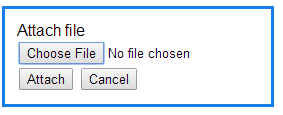
Saving a Data Entry Form
- Click Save As.
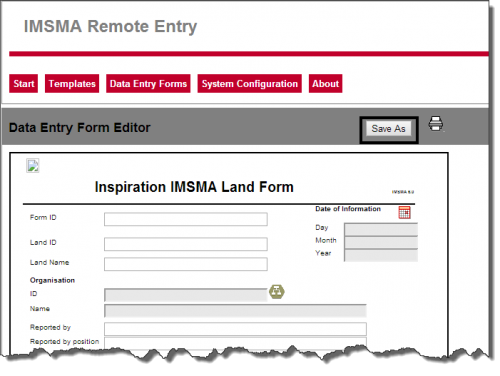
- Enter a unique file name in the Data Entry Form File Name field.
- Click Save.
- The Data Entry Form displays by file name and save date on the Data Entry Forms tab.
Exporting a Data Entry Form
- Select the check box next to each Data Entry Form to export from the Data Entry Forms tab.
- Click Export.
- The Data Entry Forms no longer display on the Data Entry Forms tab.
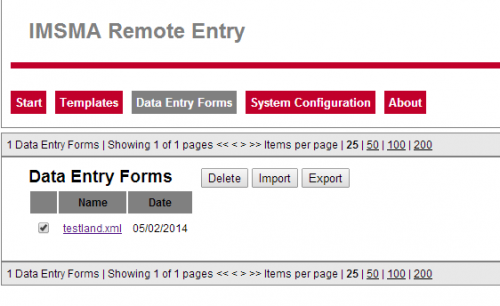
 |
Locate the .zip file of exported Data Entry Forms in your export directory. This file will be emailed to your program’s headquarters, unzipped, and imported into IMSMANG.
|
Importing a Data Entry Form
 |
You can also copy and paste a set of Data Entry Forms templates (ffml files) from IMSMANG into the C:\IMSMARE\webapp\templates directory.
|
- Click Import on the Data Entry Forms tab.
- Click Browse to locate the Data Entry Form.
 |
These instructions are for Internet Explorer Version 9 browser. Google Chrome browser users will see a Choose Files button instead of a Browse button.
|
- Select the Data Entry Form, and then click Open.
- Click Import.
- The imported Data Entry Form displays on the Data Entry Forms tab by file name and import date.
Editing a Data Entry Form
 |
Ensure that the template used to complete the Data Entry Form is stored in the c:\IMSMARE\webapp\templates folder.
|
- Click the Data Entry Form on the Data Entry Forms tab.
Editing Data
- Edit the values in numeric and alphanumeric fields.
- Click
 to edit auxiliary data, or click
to edit auxiliary data, or click  to delete auxiliary data.
to delete auxiliary data.
 |
Deleting a geospatial point that is referenced by another point will cause an error when viewing the Data Entry Form in IMSMANG.
|
Deleting an Attachment from a Data Entry Form
- Click X next to an attachment at the bottom of the Data Entry Form Editor.
The attached file is removed and no longer displays.

Saving Changes to a Data Entry Form
- To overwrite the existing Data Entry Form, click Save.
- The updated Data Entry Form displays on the Data Entry Forms tab.
- To save a new Data Entry Form, click Save As.
- Enter a unique file name in the Data Entry Form File Name field, and then click Save.
- The new Data Entry Form displays on the Data Entry Forms tab.
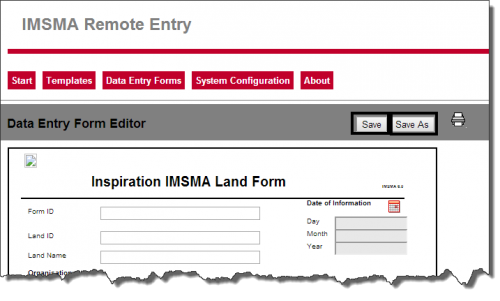
Deleting a Data Entry Form
 |
Ensure that the template used to complete the Data Entry Form is stored in the c:\IMSMARE\webapp\templates folder.
|
- Select the check box next to each Data Entry Form to delete from the Data Entry Forms tab.
-
Click Delete.
- When prompted to confirm, click Delete.
- The selected Data Entry Forms are deleted from the home directory and no longer display on the Data Entry Forms tab.
 to select a Country Structure node.
to select a Country Structure node.  to select an organisation.
to select an organisation.  to select a place.
to select a place.  to select an ordnance.
to select an ordnance.  above the Points table to open the Point dialog box.
above the Points table to open the Point dialog box. above the Points table to open the Point dialog box.
above the Points table to open the Point dialog box. above the Polygons table to open the Polygon/Polyline Editor dialog box.
above the Polygons table to open the Polygon/Polyline Editor dialog box. above the Polygon and Polyline Points table.
above the Polygon and Polyline Points table.  to edit auxiliary data, or click
to edit auxiliary data, or click  to delete auxiliary data.
to delete auxiliary data.









